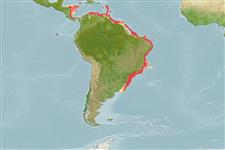Teleostei (teleosts) >
Eupercaria/misc (Various families in series Eupercaria) >
Lutjanidae (Snappers) > Etelinae
Etymology: Pristipomoides: Greek, pristis = saw + Greek, poma, -atos = cover, operculum + Greek, oides = similar to (Ref. 45335).
Eponymy: Dr Harry Wyman Freeman (1923–2012) was Professor of Biology at College of Charleston, his alma mater. [...] (Ref. 128868), visit book page.
Environment: milieu / climate zone / depth range / distribution range
Ecology
Marine; demersal; depth range 50 - 220 m (Ref. 47377), usually 50 - 150 m (Ref. 9626). Tropical; 35°N - 36°S, 86°W - 33°W (Ref. 55)
Western Atlantic: southeastern USA to Uruguay (Ref. 9626).
Size / Weight / Age
Maturity: Lm ? range ? - ? cm
Max length : 23.3 cm TL male/unsexed; (Ref. 47377); common length : 21.0 cm TL male/unsexed; (Ref. 9626)
Dorsal spines (total): 10; Dorsal soft rays (total): 12; Anal spines: 3; Anal soft rays: 8. Interorbital space flat. Eye large. Pectoral fins not reaching level of anus. Scale rows on back parallel to lateral line. Back and upper sides yellow-orange or pinkish; lower sides and belly silvery white; the caudal fin and the distal edge of the dorsal fin yellowish or orange; the remainder of the dorsal and other fins translucent or whitish.
Although the habitat is poorly known, most specimens have been trawled from relatively deep water at the upper edge of the continental shelf. Reported to occur on soft or semi-hard bottoms (Ref. 5217).
Life cycle and mating behavior
Maturity | Reproduction | Spawning | Eggs | Fecundity | Larvae
Allen, G.R., 1985. FAO Species Catalogue. Vol. 6. Snappers of the world. An annotated and illustrated catalogue of lutjanid species known to date. FAO Fish. Synop. 125(6):208 p. Rome: FAO. (Ref. 55)
IUCN Red List Status (Ref. 130435: Version 2024-1)
Threat to humans
Harmless
Human uses
Fisheries: minor commercial
Tools
Special reports
Download XML
Internet sources
Estimates based on models
Preferred temperature (Ref.
123201): 17.2 - 26.3, mean 22.2 °C (based on 127 cells).
Phylogenetic diversity index (Ref.
82804): PD
50 = 0.5005 [Uniqueness, from 0.5 = low to 2.0 = high].
Bayesian length-weight: a=0.01514 (0.00722 - 0.03173), b=2.97 (2.80 - 3.14), in cm total length, based on LWR estimates for this species & Genus-body shape (Ref.
93245).
Trophic level (Ref.
69278): 3.7 ±0.5 se; based on size and trophs of closest relatives
Resilience (Ref.
120179): High, minimum population doubling time less than 15 months (Preliminary K or Fecundity.).
Fishing Vulnerability (Ref.
59153): Low vulnerability (13 of 100).
